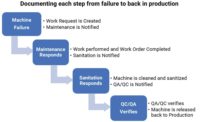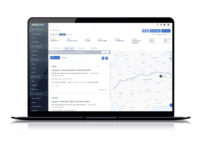Efficient fleet management is vital to the success of any snack and bakery business controlling its own distribution. These days, companies often look for fleets that have newer technology, or that are more energy-efficient, in order to improve their overall bottom line. Snack and bakery companies also have a full suite of technological tools to help streamline distribution operations.
Efficient and productive
“We are seeing a significant increase in sustainability mandates from both the public and private delivery sectors,” says Kash Sethi, VP of sales, Motiv Power Systems, Foster City, CA. “These new mandates require that delivery fleets cut down greenhouse gas emissions, ultimately by exploring alternative fuels.”
Electric vehicles (EVs) have always been the most promising method of cutting back emissions, as they reduce tailpipe emissions to zero, Sethi notes. “Additionally, fleets are finding energy efficient EVs to be a better fit for routes. Fuel savings, maintenance savings, environmental benefits, and driver benefits is making more fleets interested in EVs, beyond just mandates.”
Gary Sheldt, marketing, Workhorse Group, Inc., Cincinnati, says that one way to increase energy-efficiency is that fleet vehicle deliveries are being driven by routing and scheduling software linked to in-truck vehicle tracking, thus streamlining the delivery process. “Fleets are also adding energy-efficient fuel vehicles for better total cost of ownership. Our Workhorse C-Series step vans are the first and only medium-duty BEV made by an OEM to be certified by both the EPA and CARB, permitting sales to all 50 states,” he says.
Derek Curtis, vice president of sales, retail execution, Kӧrber Supply Chain (formerly HighJump), Hamburg, Germany, says that the concept of direct store delivery (DSD) software was created based upon the premise of improving route efficiency and productivity. “Many years ago, this was driven by removing the duplication of effort associated with re-keying orders/invoices, or reconciliation of credits. In today’s world, those types of efficiencies are more table stakes than differentiators,” he explains.
The types of improvements most operations are looking for involve driving behavior, whether that is to increase sales, capture additional store level information (i.e., competitive shelf set, or pricing), compliance tracking (i.e., lot or expiration information), or perhaps to enhance customer satisfaction (i.e., alerting of upcoming promotions, or delivery ETA), Curtis notes. “These behaviors may have traditionally been part of the tribal knowledge that field users acquired with experience, and the related tasks were expected to be remembered. The combination of increased SKU portfolios and the transient nature of many field work forces makes these expectations more and more unrealistic. Therefore, a good DSD software solution has to drive the end-user, proactively, in order to ensure all requirements are met.”
In terms of productivity, Sethi recommends EVs, as they come with many promising benefits for the fleet manager as well as the operator. “EVs are significantly quieter, and offer a much smoother ride compared to their combustion-powered counterparts, reducing driver fatigue. Refueling stops are no longer required while mid-run, allowing operators to be more productive on their routes. Fleets operating Motiv-powered electric delivery vehicles can save up to 85 percent on operations/fueling costs by switching to electric,” he explains.
Electric delivery vehicles require no regular preventative maintenance, with no oil to change or filters to replace, Sethi adds. “The number of moving parts on an EV are significantly reduced compared to a combustion-powered vehicle, meaning that long term maintenance costs are minimal. Fleets operating Motiv-powered electric delivery vehicles can save up to 85 percent on maintenance costs by switching to electric.”
Sheldt says that routing optimization through automated planning improves productivity, as many DSD drivers sometimes deliver several times to the same location in the same day. “Our Workhorse C-Series all-electric delivery vans use a proprietary telematics system called Metron, developed by Workhorse. This multi-platform application allows the DSD shipper to track and monitor the performance of each Workhorse vehicle in the fleet, collecting the data needed to optimize route planning, while monitoring maintenance and fuel costs,” he notes.
He says that C-Series features include:
- A low-floor design, which allows easy in and out access for the driver, and increases the usable volume for packages in the cargo area
- An approximately 100-mile range
- Lower operating/maintenance costs typically associated with combustion engine gas-powered vehicles
“New delivery vehicles are designed to operate with less ongoing maintenance needed, and therefore less downtime,” Sheldt explains. “Additionally, better and better mobile devices are being used today by DSD drivers—in this way, the data is timely and can withstand throughout the day usage.”
Digital signatures on delivery demands a simple-to-use, well-functioning device, he says. “Connectivity is also an important issue.” Users can control the Workhorse Metron on-board tracking system through a mobile app, viewing real-time data across all platforms: computers, tablets, and smartphones, he notes.
Jason McCourt, senior solutions consultant, Aptean, Alpharetta, GA, says that when goods are traveling directly from the supplier to the retail store, there’s even less room for error or delays than in a hub-and-spoke model that relies on distribution centers. “With Aptean’s tools such as Paragon Live Planning for resource management, which takes into account actual driver availability, fleet operators can increase vehicle utilization and/or reduce the number of trucks needed to make deliveries,” he says.
Users can configure delivery alerts/notifications, to communicate imminent arrivals and rolling ETA calculations, and even a “live” Track My Driver tool in its electronic Proof of Delivery system, fleXipod, which allows customers to see where the delivery vehicle is in real time, McCourt notes. “These features help expedite the delivery/receiving process and ensure not only an on-time arrival but an on-time departure, important to meet the ETA commitments to subsequent deliveries.”
For DSD or multi-depot delivery networks, Aptean’s Routing and Scheduling optimization software offers significant reduction in mileage, driver hours, and fuel consumption, simply by figuring out the most-efficient routes to take, McCourt adds. “Users gain huge advantages at all stages of delivery operations—planning, execution, and analyzing performance while playing out what-if scenarios to achieve further improvements. Our electronic Proof of Delivery system adds powerful features such as configurable step-by-step instructions to drivers and immediate, electronic transmission of customer signatures, photos of delivery locations, and any damage to goods, which speed up related functions such as billing, disputes and customer service operations.”
The benefits spread to other departments, too, explains McCourt. “Because our software reduces the time to plan routes from hours to minutes, the picking and packing functions in the warehouse can be completed sooner, driving warehouse efficiency and allowing for later order cut-off times.” And, because the plans assign drivers according to hours of service (HoS) restrictions and time off, the dispatch office spends less time scrambling to find the right drivers to make route plans work, getting vehicles out on the road sooner, he says.
Joe Rudolph, vice president of commercial sales, ROUSH CleanTech, Livonia, MI, says its fuel systems and advanced transportation technologies provide sufficient energy and range to support delivery methods without stopping and refueling throughout route operations. “Our propane autogas and battery electric vehicle technologies significantly reduce or eliminate noise commonly associated with diesel engine operation, allowing for standard operation in areas with noise restrictions or ordinances.”
Diesel engines require exhaust after treatment technology to achieve federal emissions compliance, explains Rudolph. “This technology often requires added time to maintain desired operation throughout the route. Displacing diesel and operating with advanced alternative fuel technologies eliminates this need and reduces the opportunity for failure or need for service by having less components and complexity.”
Newer vehicles
“Motiv-powered electric vehicles provide a significantly lower total cost of ownership (TCO) compared to similar combustion-powered vehicles,” says Sethi. “Fleets that choose to operate EVs in their fleet create a cleaner environment for the communities they operate in, while simultaneously benefiting from long-lasting vehicles that are cheaper to own and operate. The financial benefits are even more staggering when leveraging incentives and grants.”
Sheldt says that there are three important benefits to newer fleet vehicles: improved vehicle technology, reduced vehicle maintenance costs, and better fuel efficiency. “Improved vehicle technology includes rear-view cameras, hands-free smartphone connections, improved navigation systems. Technology advancements like these reduce the likelihood of driving accidents and protect driver safety. GPS and Navigation technology, like the Workhorse Metron system, also provide better routes for the driver, improving efficiency for delivery times and produce better customer satisfaction,” he recommends.
As for reduced vehicle maintenance costs, older fleets often require lengthier and more-expensive maintenance due to the heavy usage and wear and tear they experience on an ongoing basis, advises Sheldt. “A newer fleet vehicle is at the start of its usage cycle—companies can spend valuable financial resources on company growth and customer retention, rather than constant fleet vehicle repairs and maintenance. Additionally, all-electric fleet vehicles require less ongoing maintenance and offer a lower total cost of ownership.”
In the area of better fuel efficiency, fleet management benefit in big savings in annual fuel costs, Sheldt notes. He notes that Workhorse C-Series vehicles deliver efficiency via:
- All-electric propulsion for lower operating costs per mile
- Light-weighted body construction for more miles per gallon equivalent
- The modular battery pack that can be configured to meet the exact mileage of each delivery route
Rudolph says that the economics of fleet vehicles operating on propane autogas are hard to ignore. “On average, propane autogas costs up to 40 percent less than gasoline, and up to 50 percent less than diesel. Propane vehicles don’t require complex after treatment systems or the timely regeneration that follows. The fuel operates cleanly through the engine, and fleet managers report savings of 30 to 50 percent on filters and fluids,” he adds.
Propane vehicles have no cold-start issues and warm up quickly, saving time and money on equipment and staff. And with quick fill-up time and a long driving range, propane autogas vehicles stay on the road, Rudolph explains. “Delivery fleets can transition from diesel to propane autogas without incentives, but federal and state incentives are available and further accelerate savings. In addition to the cost savings, there are significant emissions reductions. Propane autogas vehicles emit fewer greenhouse gases and total hydrocarbon emissions, and virtually eliminate particulate matter.”
In fact, propane autogas engine technology has progressed to the point where nitrogen oxide (NOx) emissions are reduced to near zero, notes Rudolph. Currently there are more than 2,600 food and beverage delivery fleet vehicles running on propane autogas. “NOx emissions are federally regulated due to their negative impact on human health and the environment. According to the EPA, they can trigger health problems in your drivers, including asthma, bronchitis, and other respiratory issues. ROUSH CleanTech’s propane autogas engine is 90-percent cleaner than the Environmental Protection Agency’s most stringent 0.2 gram standard.”
Time-sensitive software
Often, orders can be time-sensitive, and companies need “real-time” software that can keep up.
Curtis says that Körber DSD software is deployed on a device-agnostic platform, and as such its mobile solution takes advantage of the pervasive cellular connectivity that so many consumers enjoy. “With our real-time connectivity, users have full visibility of inventory, both in the warehouse and on mobile trucks in the field. As such, if an immediate service requirement order request comes in, we provide the ability to assess which route has available inventory, and the order can be assigned to that route,” he notes.
The order is communicated to the mobile route, and the user is alerted to the route change that requires their attention. If desired, these processes can involve an assessment to see what the cost implication of the additional stop requirement has to each potential route evaluated, Curtis explains. “Körber DSD software should be designed specifically for perishable product distribution. One of the unique benefits of this approach is that no source code customization is ever deployed. Instead, a highly configurable solution covers the vast majority of requirements,” he says.
“In the case that new functionality is required, it is built into the general release—updated with major releases three times per year—for the benefit of our entire user community. An example of this benefit can be seen in the increased demand for Scan-Based Trading (SBT), as COVID19 has pushed grocery stores to request/limit human presence in the stores. By providing user-friendly SBT options, along with other industry-focused benefits—such as predictive ordering algorithms, product traceability, or Geofence arrival/departure alerts—users can take advantage of trends in the marketplace,” Curtis recommends.
McCourt says that Aptean’s Paragon Routing and Scheduling solution allows users to enter time windows as narrow as required by the customers, and gives a far better chance of hitting them because the route plans incorporate factors that have an impact on on-time deliveries, such as average road speed on routes being followed, and typical time taken to deliver to other customers on the route. “Our route optimization software also allows fleet operators to prioritize specific customer deliveries as needed,” he adds.
“For example, a supermarket will typically get multiple deliveries per day of fresh, frozen, and ambient product,” says McCourt. “Usually, frozen and ambient products can arrive at the store at any time, but fresh produce has to arrive before the store opens so the product can be on the shelves, and the store looking its best as the doors open. The software is easily configurable by the user to take such considerations into account.”
With Aptean’s Paragon Live Planning offering, users get access to management tools such as its Arrivals Board and Live Dashboard, which create a transport planning and execution environment where critical data is shared across the whole business, rather than being stored in separate silos, McCourt explains. “Colleagues from sales and marketing to finance and customer services can be given access to historic and real-time information. Typical benefits are improvements to store efficiency and improved vehicle turnaround time.”
The Analysis component allows Aptean’s Paragon customers to gain a greater understanding of what is happening within their operations, via a wide range of transport-related metrics—including vehicle usage, planned versus actual comparisons, distance per drop and on-time performance. Interactive business intelligence charts that collate these factors can be accessed online in order to review the performance of a single site or multiple locations, says McCourt. “Paragon, now part of Aptean, was founded mainly as a strategic tool rather than originating from execution-based application, so it’s as strong from a strategic planning perspective as it is flexible as an execution-based application.”
The overall result is that fleet operators find themselves in a cycle of continuous improvement, constantly inputting fresh information to help them fine-tune delivery operations to gain maximize efficiency and superlative customer service, says McCourt. “It’s really all about harnessing the power of computers to continuously crunch huge numbers of factors and possible outcomes in order to arrive at the absolute optimal operational outcome, while freeing humans to do what they do best—look for innovative, strategic improvements to delivery performance.”








